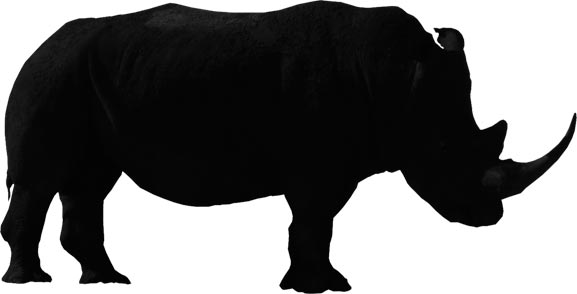Text RNOR11 £3
to 70070
(£1 - £5 & £10)
About
Find a few facts about rhinos! Click on the rhino prints below to discover a few snippets. Follow the links below for more information about awesome rhinos.

- There are five species of rhino, two in Africa (white rhino, black rhino), three in Asia (Greater one horned rhino, Javan rhino, Sumatran rhino)
- The global population of rhinos is estimated at less than 27, 000, all species are in danger of extinction.
- All rhino species are threatened by habitat loss, and in particular being killed for their horn.
- All rhino species can reach over one tonne in weight
- All rhino species have three toes on their feet and leave a characteristic footprint in the ground as they walk.
- All rhinos are known as mega herbivores, they eat vegetation and are one of the largest animals left on the planet.
- The smallest rhino is the Sumatran, standing at just over one metre in height. The largest is the white rhino at around two metres at the shoulder.
- Tragically, two sub-species, the Western Black Rhino and the Vietnamese Javan rhino, were both declared extinct in 2011.
- There are two subspecies of white rhino, the Southern and Northern whites. The latter is thought to consist of only eight known individuals. It is hoped more will be found in the wild.
- Four Northern White rhinos have been returned to Africa from a Zoo in the Czech Republic. It is hoped they will breed.
- The black rhino can run at speeds of up to 35mph and is very quick off the mark, agile, and can run straight through thick vegetation. The best way to escape is to climb a tree...very quickly!
- The white rhino is the biggest rhino, it can easily turn over a 4x4 if it wanted to. The white rhino has a very wide mouth helping it to graze grass effectively
- The Sumatran rhino has two horns and is the most furry of the rhinos, the babies in particular are covered in fur when they are born.
- The Javan rhino is the rarest rhino, and is very difficult to see as it lives in thick rainforest. It has one horn and an armoured appearance like the one horned rhino, but is smaller.
- The greater one horned rhino is almost as big as the white rhino, its body has an armour plated appearance created by thick skin folds, it has one horn and has sharp teeth at the front of its mouth which it uses to fight and defend itself.
- Rhino numbers:
White rhino: c.20,000
Black rhino: c.4,200
Greater one horned rhino: c.2,800
Javan rhino: c.20 - 40
Sumatran rhino: c. 200
- The black rhino is not black, nor is the white rhino white: the word white is a mis-pronunciation of the word ‘wide’, so used to describe this rhinos’ wide mouth. The black rhino was discovered later and simply named the opposite colour.
- Rhinos are all descended from a common ancestor, a small and hornless mammal resembling a tapir or small horse more than a rhino.
- One type of rhino, the Indricotherium which existed about 40 million years ago, was thought to be the biggest land mammal ever known on Earth at over five meters tall, it was larger than a mammoth!
- Rhinos have few natural predators, although young or old rhinos can fall prey to big cats. Their main predator is humans.
- Rhino horn is in demand for use as dagger handles in Yemen and an ingredient in Traditional Asian medicines where is it falsely believed to have medicinal properties.
- Rhino horn consists of mostly keratin, a protein, and is the same as all animal horn, hoofs and nails, including human nails.
- Rhinos need their horns for self defense, to compete with other rhinos, to defend their young and to help them access food in thick bush and find herbs in long grass.
- Rhinos have poor eyesight but fantastic hearing.
- Rhinos have a very sensitive sense of smell, warning them of danger and helping them find food and other rhinos.
Links

